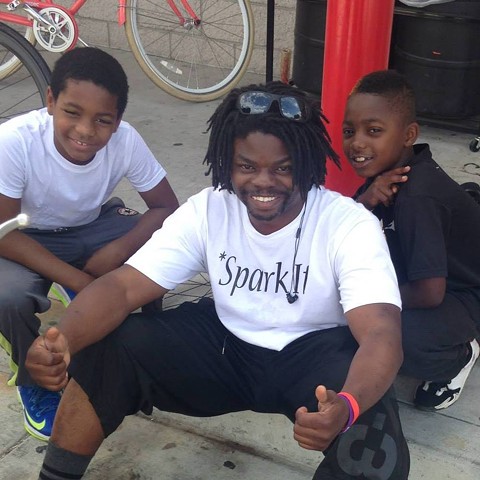I once moved my possessions from one apartment to another--on my bicycle.
Granted, I didn't have much at the time. Still, I take pride in having changed residences without the aid of trucks, vans or moving companies. For me, the experience affirms what someone--an old riding buddy, if I recall correctly--once told me: You can carry anything on a bicycle. It's just a matter of loading and packing it.
A fellow in Oxford, Ohio apparently followed that advice. He transported a mini-refrigerator and full-length mirror aboard a pink Mongoose bicycle.
Of course, Stephen Moster didn't have those items on his back or shoulders, or strapped to a Blackburn rear carrier, as he pedaled along. For that matter, he wasn't hauling a modern bike trailer or even a vintage Cannondale bugger. Instead, he was pushing a shopping cart loaded with the refrigerator and mirror.
I would have respect and even admiration for him: After all, it takes a certain amount of ingenuity to conceive of such a system, and a certain level of skill to ride while pushing a cart. And, yes, he showed that something could be done without a motor vehicle when most people would have assumed that one was necessary.
I would have respect for him...if the refrigerator and mirror were his, or he were transporting them for a friend--or even if someone was paying him to move them. Or if his story--that two men invited him to "take whatever I want" from a house they were cleaning up--were true.
You know where this is going: He burgled that house. In fact, the two men were cleaning up from a previous burglary and talking with an insurance representative when they were startled by sounds. They went to a neighbor's porch, where they watched Moster take the refrigerator and mirror. Realizing he couldn't carry them on his bike, he left and then returned with a Kroger's grocery cart.
(This is how he should have done it!)
Hmm...The refrigerator and mirror were burgled and the cart was "appropriated". It makes me wonder how he acquired the bicycle.
I still must say that I sort of admire his ingenuity. But I would offer him this bit of advice: If you're going to abscond with other people's property, don't do it on a pink bike!
Granted, I didn't have much at the time. Still, I take pride in having changed residences without the aid of trucks, vans or moving companies. For me, the experience affirms what someone--an old riding buddy, if I recall correctly--once told me: You can carry anything on a bicycle. It's just a matter of loading and packing it.
A fellow in Oxford, Ohio apparently followed that advice. He transported a mini-refrigerator and full-length mirror aboard a pink Mongoose bicycle.
Of course, Stephen Moster didn't have those items on his back or shoulders, or strapped to a Blackburn rear carrier, as he pedaled along. For that matter, he wasn't hauling a modern bike trailer or even a vintage Cannondale bugger. Instead, he was pushing a shopping cart loaded with the refrigerator and mirror.
I would have respect and even admiration for him: After all, it takes a certain amount of ingenuity to conceive of such a system, and a certain level of skill to ride while pushing a cart. And, yes, he showed that something could be done without a motor vehicle when most people would have assumed that one was necessary.
I would have respect for him...if the refrigerator and mirror were his, or he were transporting them for a friend--or even if someone was paying him to move them. Or if his story--that two men invited him to "take whatever I want" from a house they were cleaning up--were true.
You know where this is going: He burgled that house. In fact, the two men were cleaning up from a previous burglary and talking with an insurance representative when they were startled by sounds. They went to a neighbor's porch, where they watched Moster take the refrigerator and mirror. Realizing he couldn't carry them on his bike, he left and then returned with a Kroger's grocery cart.
(This is how he should have done it!)
Hmm...The refrigerator and mirror were burgled and the cart was "appropriated". It makes me wonder how he acquired the bicycle.
I still must say that I sort of admire his ingenuity. But I would offer him this bit of advice: If you're going to abscond with other people's property, don't do it on a pink bike!


















